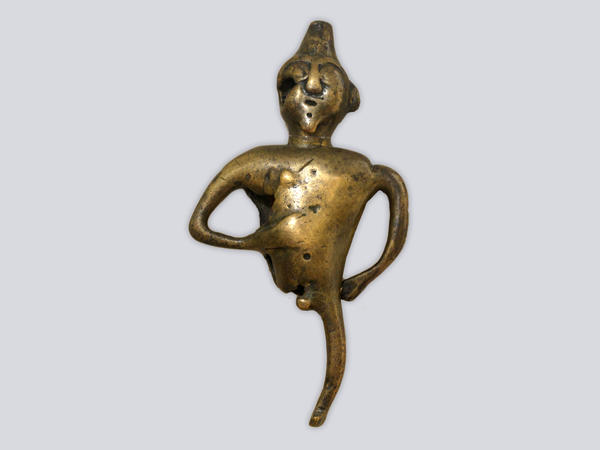Among the objects discovered during archaeological excavations in what used to be Volga Bulgaria, there is a unique group, idols with multiple faces, proving that paganism flourished there in the 12-th-13th centuries. One item on display is especially valuable to researchers: it is a double-sided figure discovered during excavations of the Zmeyovo settlement site, which has both masculine and feminine features. No other androgyne idols have ever been found.
Two-sided idol
Creation period
12th-13th centuries
Dimensions
18,2x9,5x3,4 cm
18.2х9.5х3.4 cm
18.2х9.5х3.4 cm
Technique
bronze, casting
Exhibition
3
Open in app#1
Two-sided idol
#7
#8
The figure’s author imparted a very expressive countenance to the feminine half. Her eyes are wide open, her cheeks puffed out, and the lips shaped into the letter o. The left arm is bent and the palm is pressed to the solar plexus, the right hand rests on the hip.
The masculine entity of the idol copies the reverse side, but the body language is calmer: the other face shows only slightly up-drawn eyebrows.
#4
Another half ot the idol - a woman
#9
Both halves of the idol have obvious defects. In the stead of one ear, a cavity is yawning, the hands have different length, the only leg is too thin for a massive body and ends with an unnaturally small foot. Art experts believe that the figure caster made these imperfections intentionally, to neutralize the idol’s magic capabilities by means of defects.
#10
In researchers’ opinion, the idol was part of a different object, but they can’t confidently say what it was. According to one version, a rod connected with a stable support went through the figure’s body. The role of support may have been played by a horse statuette, a popular item in Bulgarian culture. Another theory is that the idol could be a pendant for a check-lock. They usually served as room decorations and charms.
#6
Scholars’ views differ as to how significant this idol was for the Central Trans-Kama region. They suppose it was either part of the home interior pretties or a sacral item. In experts’ view, each side could have performed a separate magic function, for instance attract luck or protect against the dark forces. This version is corroborated by the fact that the physiological differences of the two sides are shown by the author in such detail.
#11
National Museum of the Republic of Tatarstan
read morehide
00:00
00:00
1x
Two-sided idol
Creation period
12th-13th centuries
Dimensions
18,2x9,5x3,4 cm
18.2х9.5х3.4 cm
18.2х9.5х3.4 cm
Technique
bronze, casting
Exhibition
3
Open in app
Share




